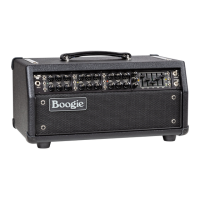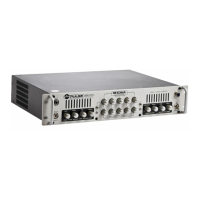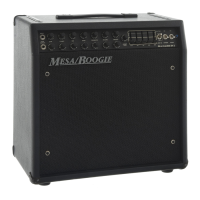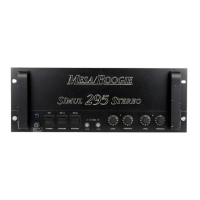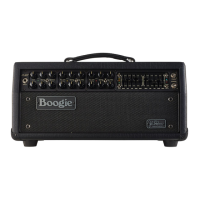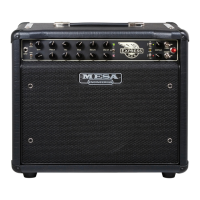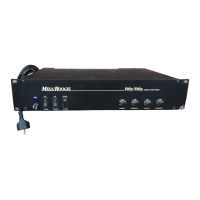harmonics and even more urgent attack than its cousin upstairs, the IIC+ Mode. This hyper reactive voice jumps at the first hint of
pick attack and roars with aggression. It’s further antagonized by the similar response of the EL84 power tubes here in the FIVE: 35
with their fast attack, higher mid frequency and relative lack of sub-low bottom end. XTREME shreds, grinds and thrashes like the
angry teen that it is circuit-wise and whatever it lacks in nuance, it makes up for in brash attitude. It’s very fast, forward and furious and
should be used in musical environments where you don’t care if you offend and/or dominate... and in fact, this may even be the goal.
5-BAND GRAPHIC EQ
The on-board 5-Band Graphic EQ has been an iconic trademark of MARK Series Boogies since it first
appeared on the MARK I back in 1970. The shaping power of this feature can’t be denied, especially when combined with the MARK II
and IV’s tight, mid-focused gain sound. In the ‘80s, the mid-scooped “V” setting of the Graphic EQ on MARK II and III models became
an instant Classic among well known Artists for crunch rhythm and high gain solo sounds. With bigger chunking low end, scooped
mids for width and a chirping harmonic top, these MARK amps were nice alternatives to the Brit-mods of the day. They quickly took
their place as the other sound in Heavy Rock, etching the on-board Boogie Graphic a nice little niche in Rock history.
While the MARK FIVE: 35 Tone Controls are accurate and effective over a wide range, they come earlier in the preamp’s signal path
and can only achieve so much shaping before they produce possible imbalances in certain Modes. One example might be the BASS
Control in Channel 2 where, in the MARK II-C+ and MARK IV Modes, too much bass dialed up early in the preamp will cause the
sound to be tubby and unfocused.
The Graphic EQ comes at the very end of the signal chain so you can shape the final sound with the only consideration being how
much of a certain frequency your speakers, cabinet—and ultimately your ears—can handle. The only consideration is that here in this
35 Watt (or lower) power section, extreme settings of the two lowest Bands — 80Hz and 240Hz will use up power (wattage) quickly
and overall headroom will be affected. This is even more of a consideration in the 10 Watt Power setting. Dial with care and taste
to ensure the best performance. Subtle movements cause substantial results here, so use this powerful tool wisely and it can take
your sound almost anywhere you want to go. Just be sure to reference less altered sounds from time to time to keep a perspective,
as it’s easy to get an “EQ Hangover”.
Each Channel is fitted with a mini-toggle just to the left of the SLIDERS to select the operational status of the 5-Band Graphic EQ and
the FIVE: 35 gives you a choice of two ways to utilize its shaping power. In each Channel you can decide whether you want the EQ
active all the time in that Channel—EQ ON (toggle up), bypassed all the time in that Channel—EQ OFF (toggle center), or activated
by the EQ button on the Footswitch—EQ FS (toggle down). There is also an Orange LED in between the switches to keep you ap-
prised of EQ status that illuminates when the EQ is active, regardless of how it has been engaged.
MULTI-WATT™ Channel Assignable Power
To the right of the Graphic EQ SLIDERS are the Multi-Watt™ Channel Assignable
Power switches for each Channel. These allow selection of either the full 35 watts of Dyna-Watt™ power utilizing all four power tubes
with its more-than-rated punch and impressive burst of headroom on the attack, or the increased sag and looser feeling options of
the two lower power options. Each of those (10 and 25 WATTS) sound and react a little different and offer a slightly brighter and oh-
so-clip-able Class AB power with 25 WATTS being wired in Pentode–for increased punch and a more defined attack–and 10 WATTS
being wired in Triode for the ultimate in smooth power clip. The Blue LED lamp in the center of the Panel between the Multi-Watt
switches is the AC Pilot light.
The 35 and 25 WATT Settings are the choice for the majority of those who will be gigging or rehearsing with others and they provide
the maximum volume for clean sounds and the tightest tracking response for high gain rhythm work, especially in the low end. The 35
WATT selection’s bouncy, elastic feeling response was originally created in a two tube array created in 1984 and was the engine behind
our first low wattage amp, the STUDIO .22, and its shocking performance. Later, our four tube EL84 models such as the Dual Caliber
and Nomad Series put this dynamic power section to good use. Explosive, dynamic speed, an easy to play feel and the impression
of power far beyond its rated wattage have kept it at the center of our low wattage offerings for 30 years now. This incarnation pairs it
with the MARK Series preamp, which is also dynamic, expressive and touch sensitive and together they create an incredible playing
experience that’s as magic as it is versatile and portable.
The 10 Watt setting flips the 2xEL84s over to a CLASS A/B Triode wiring configuration that offers an opposite power response to
Dyna-Watt along with greatly increased clip-ability. It produces a skinnier, slightly brighter response and is the same low power scheme
PAGE 4
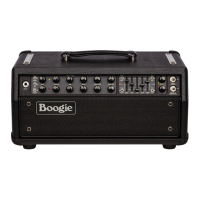
